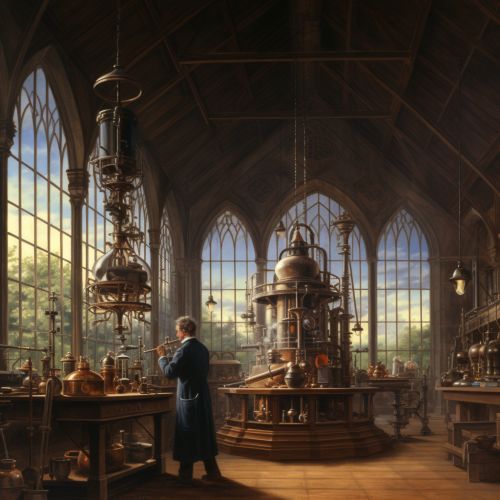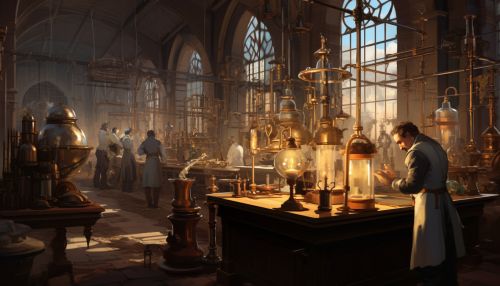Oxygen
Introduction
Oxygen is a chemical element with the symbol O and atomic number 8. It is a member of the chalcogen group on the periodic table, a highly reactive nonmetal, and an oxidizing agent that readily forms oxides with most elements as well as with other compounds. By mass, oxygen is the third-most abundant element in the universe, after hydrogen and helium. At standard temperature and pressure, two atoms of the element bind to form dioxygen, a colorless and odorless diatomic gas with the formula O2. Diatomic oxygen gas constitutes 20.8% of the Earth's atmosphere. As compounds including oxides, the element makes up almost half of the Earth's crust.
Discovery and naming
Oxygen was discovered independently by Carl Wilhelm Scheele, in Uppsala, and Joseph Priestley in Wiltshire, both in the 1770s. Priestley is often given priority because his work was published first. The name oxygen was coined in 1777 by Antoine Lavoisier, whose experiments with oxygen helped to discredit the then-popular phlogiston theory of combustion and corrosion. Its name derives from the Greek roots ὀξύς (oxys) ("acid", literally "sharp", referring to the sour taste of acids) and -γενής (-genēs) ("producer", literally "begetter"), because at the time of naming, it was mistakenly thought that all acids required oxygen in their composition.


Characteristics
Oxygen is a very reactive element and is capable of combining with most other elements. It is required by most living organisms and for most forms of combustion. Impurities in molten pig iron are burned away with streams of high pressure oxygen to produce steel. Oxygen can also be combined with other elements in several different ways to produce compounds that are useful in daily life. For example, water is a compound of oxygen.
Physical properties
At standard temperature and pressure, oxygen is a colorless, odorless, and tasteless gas. Oxygen condenses at −182.95°C and freezes at −218.4°C. Liquid and solid O2 are pale blue and are strongly paramagnetic. O2 molecules have a bond length of 121 pm and a bond energy of 498 kJ/mol. Because of its unpaired electrons, it is attracted into a magnetic field.
Chemical properties
Oxygen is a strong oxidizing agent and has the second-highest electronegativity of all reactive elements, second only to fluorine. The element is reactive and can form oxides with all elements except helium, neon, argon, and krypton. It forms compounds by reaction with practically any other element, as well as by reactions that displace elements from their combinations with each other.
Allotropes
The common allotrope of elemental oxygen on Earth is called dioxygen, O2, the major part of the Earth's atmospheric oxygen (see Occurrence). O2 has a bond length of 121 pm and a bond angle of 117.4°. Since the O2 molecule is not a perfect sphere, it has a nonzero dipole moment and it is polar. The molecule is paramagnetic. Another form (allotrope) of oxygen, ozone (O3), strongly absorbs ultraviolet UVB radiation and consequently the high-altitude ozone layer helps protect the biosphere from ultraviolet radiation.
Biological role
Oxygen is essential to all human life and makes up 65% of the human body by mass. It is a key component of bioenergetics, playing a critical role in the process of cellular respiration. In this process, oxygen reacts with glucose to produce carbon dioxide, water, and energy in the form of ATP. Oxygen is also involved in many other biological reactions, including the process of photosynthesis, in which plants convert carbon dioxide and water into glucose and oxygen in the presence of sunlight.
Industrial production
Oxygen is produced industrially by air separation. The atmosphere is first cooled until it liquefies, then the liquid air is separated into its components by distillation. Oxygen can also be produced through the electrolysis of water or by heating potassium chlorate (KClO3).
Applications
Oxygen has many uses in the industrial, medical, and scientific fields. It is used in steelmaking, in chemical reactions, and in the manufacture of a wide variety of products. In medicine, oxygen is used in oxygen therapy and in life support systems. In science, it is used in both biological and chemical research.
Safety and precautions
While oxygen itself is not flammable, it supports combustion. Materials that burn in air will burn more vigorously in oxygen. High concentrations of oxygen can cause rapid combustion. Oxygen equipment should be handled with care to prevent accidents.
